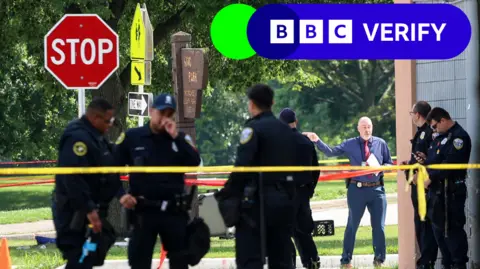 Getty Images
Getty ImagesViolent crime is one of the key issues in the US election, with research suggesting that many Americans believe it is on the rise.
But the latest FBI crime data shows it fell last year.
The much-anticipated report, released on Monday, shows declines across several serious crimes including rape, robbery and aggravated assault.
The number of murders saw the largest drop in 20 years, according to the FBI.
What does new FBI data show?
Violent crime – as recorded by the FBI – includes homicide, rape, robbery and aggravated assault reported to and recorded by police forces.
Its latest report shows that violent crime fell by an estimated 3% between 2022 and 2023.
Murder and non-negligent manslaughter reduced by 12%, the largest drop in the last 20 years.
The report also shows falls in:
- Rape by 9%
- Robbery by 0.3%
- Aggravated assault by 3%
In 2023, the FBI recorded a rate of 363.8 violent crimes per 100,000 people, down from the 2022 rate of 377.1 violent crimes per 100,000 people.
Reported violent crime has fallen year-on-year since 2020.
But while violent crime is down, some non-violent crimes are up. In 2023, motor vehicle theft rose by 13%.
Submitting data to the FBI is voluntary and in recent years some police forces have not done this.
In 2021, the participation rate was around two thirds because many agencies – including in New York and Los Angeles – did not submit data to a new FBI system.
Donald Trump regularly criticises the FBI data and his website says it “is missing nearly a third of the nation’s law enforcement agencies — including from many of the most violent cities, such as Chicago, Los Angeles, San Francisco, Oakland, and New Orleans”.
But participation has steadily improved and in 2023 more than 85% of agencies enrolled in the FBI’s data collection system submitted figures.
The FBI says every city agency covering a population of one million or more residents contributed a full 12 months of data in 2023.
Daniel Flannery, a professor specialising in violence prevention research, says that generally it is the smaller agencies that do not submit data.
“Many of them don’t have their own data people. Suburban and and rural communities tend to be the ones not submitting the data because they lack resources,” he says.
Are there other measures of violent crime?
The other way of tracking US violent crime is through a nationwide survey of about a quarter of a million people.
The National Crime Victimization Survey asks them whether they have been victims of crime and whether they reported these offences to the police (in 2023, only around half of them did).
Violent crime, as recorded by the survey, includes rape or sexual assault, robbery, aggravated assault, and simple assault. It does not count murder.
Donald Trump regularly highlights this survey as proof that “violent crime nationwide is up 40%” since 2020.
This figure is right, according to the latest crime survey statistics.
They show that the rate of violent crime per 1,000 of the population did increase by this much between 2020 and 2023.
However, Trump is making a comparison with a year when violent crime – as measured by the survey – was significantly lower.
Prof Flannery says “picking a year during Covid that may represent the lowest crime rates then comparing to a more ‘return to normal year’ cherry picks two points in time. Comparing 2023 to a pre-Covid year may be more appropriate.”
The survey says that “while the 2023 rate was higher than those in 2020 and 2021, it was not statistically different from five years ago, in 2019”.
What do longer term crime trends show?
Both of the main data sources show violent crime has fallen in the past three decades.
FBI data shows a 49% reduction in the rate of violent crime between 1993 and 2022, with large decreases in the rates of robbery (down 74%) and murder (down 34%), according to analysis by the Pew Research Center.
Likewise, the victims’ survey from the Bureau of Justice Statistics shows a 71% decline over the same period.
On the reduction in violent crime, Prof Flannery says it’s “partly because we’re getting better at understanding what drives violent crime, which tends to be a small number of people in a community committing repeat offences. It’s also about targeted policing strategy and intervention.”
Marc Levin, Chief Policy Counsel at the Council on Criminal Justice, says that other factors may be influential in bringing crime levels down.
“We don’t know all the reasons crime fluctuates but some of it is obviously demographic. We’re an aging society which generally speaking should lead to less crime.
“There are also environmental factors like streetlighting which help with crime prevention. Evidence suggests it makes the potential perpetrators of crimes like robbery and auto-theft believe they’re going to be caught,” he argues.



